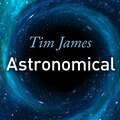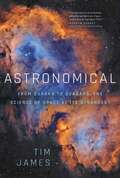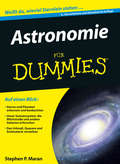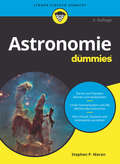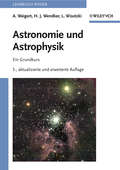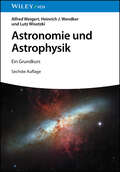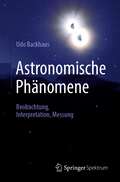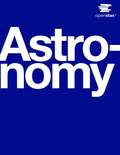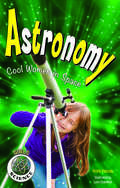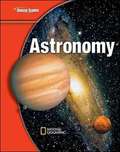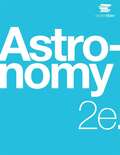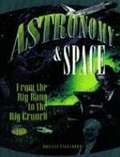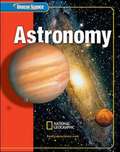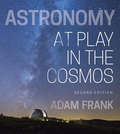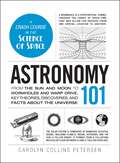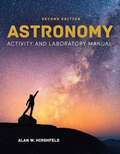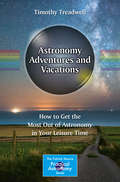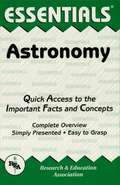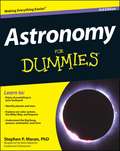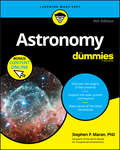- Table View
- List View
Astronomical: From Quarks to Quasars, the Science of Space at its Strangest
by Tim James'In the same light-heartedly informative spirit as his previous Elemental, Tim James gives us an entertaining gallop through light years of space science, from the big bang to UFOs'Andrew Crumey, author of The Great Chain of UnbeingPRAISE FOR THE AUTHOR'Humorous, yet deep . . . Fundamental will speak to all readers' Professor Charles Antoine, Sorbonne University'Who said science was dry? Certainly not Tim James' New York PostDoes the Big Bang prove the existence of God? What's the Universe expanding into? Is Earth the only planet which supports life? Why did the greatest astronomer in history murder his pet moose?Space is the biggest, oldest, hottest, coldest, strangest thing a human can study. It's no surprise then, that the weirdest facts in science (not to mention the weirdest scientists themselves) are found in astrophysics and cosmology. If you're looking for instructions on how to set up your grandad's telescope this book probably isn't for you. In Astronomical, Tim James takes us on a tour of the known (and unknown) Universe, focusing on the most-mind boggling stuff we've come across, as well as unpacking the latest theories about what's really going on out there.Guiding us through Einstein's relativity, quantum mechanics and string theory, Astronomical delves into the baffling corners of the cosmos and tackles the biggest mysteries we face: from alien life to the zodiac; from white holes to wormholes; from quasars to quark stars. This is the science of space at its absolute strangest! From the creation of the Universe out of nothing to the Large Hadron Collider and the Universe's ongoing expansion, Tim explores our planetary neighbours, where it snows metal on Venus, there are underground lakes on Mars and rivers of petrol on Titan. He then looks beyond our solar system: to exoplanets which could support life, rogue planets, quark stars, quasars, neutron stars and more. Tim looks at black holes (and how to survive in one), wormholes, white holes as well as dark energy, dark matter and even a bit of string theory thrown in for good measure. He explains the search for extra-terrestrial intelligence, including the discovery of Martian fossils in the Alan Hills meteorite and the tantalising 'Wow signal' transmission earth received in 1973 - still unexplained. He also rebuts resurgent anti-science movements, including the Flat Earth Society and discusses what's really going on inside Area 51.To close, Tim finishes by looking at human achievements in space including how rockets work, how faster-than-light warp-drives (currently being investigated by NASA) work and how we plan to colonise both the moon and Mars.
Astronomical: From Quarks to Quasars: The Science of Space at its Strangest
by Tim JamesGuiding us through Einstein's theory of relativity, quantum mechanics, and string theory, Astronomical explains the baffling mysteries of the cosmos: from alien life to the zodiac; from white holes to wormholes; from quasars to quark stars—all within a narrative that is as entertaining as it is edifying.Does the Big Bang prove the existence of God? What's the Universe expanding into? Is Earth the only planet which supports life? Space is the biggest, oldest, hottest, coldest, strangest thing a human can study. It's no surprise then, that the weirdest facts in science (not to mention the weirdest scientists themselves) are found in astrophysics and cosmology. If you're looking for instructions on how to set up your grandad's telescope this book probably isn't for you. In Astronomical, Tim James takes us on a tour of the known (and unknown) universe, focusing on the most-mind boggling stuff we've come across, as well as unpacking the latest theories about what's really going on out there. Guiding us through Einstein's relativity, quantum mechanics and string theory, Astronomical delves into the baffling corners of the cosmos and tackles the biggest mysteries we face: from alien life to the zodiac; from white holes to wormholes; from quasars to quark stars. This is the science of space at its absolute strangest.
Astronomically Speaking: A Dictionary of Quotations on Astronomy and Physics
by Carl C. Gaither Alma E. Cavazos-GaitherTo understand the history, accomplishments, failures, and meanings of astronomy requires a knowledge of what has been said about astronomy by philosophers, novelists, playwrights, poets, scientists, and laymen. Astronomically Speaking: A Dictionary of Quotations on Astronomy and Physics serves as a guide to what has been said about astronomy through the ages, from the past to the present. Containing approximately 1,550 quotations and numerous illustrations, this resource is the largest compilation of astronomy and astrophysics quotations published to date. A quick glance through the table of contents illustrates the variety of topics discussed. Readers can quickly and easily access the wit and wisdom of several hundred scientists, writers, philosophers, poets, and academics using the comprehensive indexes.
Astronomie für Dummies (Für Dummies)
by Stephen P. MaranFinden auch Sie die Weiten des Kosmos faszinierend und fragen sich, wie Wissenschaftler so viel über Objekte in unerreichbarer Ferne wissen können? "Astronomie für Dummies" bringt Ihnen die Weiten des Universums näher: Erkunden Sie unser Sonnensystem, ferne Galaxien und die Milchstraße. Lesen Sie wie in einem Krimi von schwarzen Löchern, dem Asteroidengürtel und der Entstehung des Universums. Außerdem gibt Stephen Maran viele Tipps zur richtigen Ausrüstung eines Astronomen. So können Sie schon bald selbst nach den Sternen greifen.
Astronomie für Dummies (Für Dummies)
by Stephen P. MaranFinden auch Sie die Weiten des Kosmos faszinierend und fragen sich, wie Wissenschaftler so viel über Objekte in unerreichbarer Ferne wissen können? "Astronomie für Dummies" bringt Ihnendas Universum näher: Erkunden Sie unser Sonnensystem, ferne Galaxien und die Milchstraße. Lesen Sie wie in einem Krimi von schwarzen Löchern, dem Asteroidengürtel und der Entstehung des Universums. Außerdem gibt Stephen Maran viele Tipps zur richtigen Ausrüstung eines Astronomen. So können Sie schon bald selbst nach den Sternen greifen.
Astronomie und Astrophysik: Ein Grundkurs
by Alfred Weigert Heinrich J. Wendker Lutz WisotzkiDieses Lehrbuch ist ein Grundkurs im besten Sinne: Beginnend mit den physikalischen und technischen Grundlagen, die fur das Verstandnis der weiteren astrophysikalischen Ausfuhrungen benotigt werden, vermittelt es solides Wissen fur die moderne Astrophysik, ist klar geschrieben, reich bebildert und auch in den mathematischen Teilen jederzeit verstandlich. Nun liegt das Buch in der 5. Aufl age vor - vollstandig aktualisiert und um das Kapitel Extrasolare Planetensysteme erweitert von Lutz Wisotzki, der bereits die letzte Aufl age mit verantwortete. Studenten der Physik und Astronomie im Grundstudium wie auch Fachleute und Amateure schatzen dieses Buch fur Schule, Studium und Freizeit.
Astronomie und Astrophysik: Ein Grundkurs
by Alfred Weigert Heinrich J. Wendker Lutz WisotzkiDer Klassiker zum Einstieg in die Astronomie und Astrophysik Die sechste Auflage dieses Lehrbuchs ist der ideale Einstieg für alle, die sich auf Universitätsniveau mit Astronomie und Astrophysik beschäftigen möchten. Dank der klaren Sprache, der reichen Bebilderung und der Beschränkung auf die notwendigste Mathematik ist es unvergleichlich verständlich und vermittelt so ein umfangreiches astronomisches und astrophysikalisches Grundwissen. Die vorliegende sechste Auflage ist eine umfassende Neugestaltung, die weit über die Aktualisierung einzelner Abschnitte hinausgeht: komprimierter Abriss physikalischer Grundlagen am Anfang des Buchesneues Kapitel „Erde und Mond“kondensiertere Darstellung der Sternphysikneues Kapitel „Entstehung und Entwicklung von Galaxien“überarbeitete und neue Abbildungenneue Aufgaben Damit stellt das Buch die etablierte Grundlage gesicherten Wissens dar und ermöglicht zugleich die Teilhabe an den atemberaubenden Erkenntnisfortschritten in der aktuellen astrophysikalischen Forschung.
Astronomische Phänomene: Beobachtung, Interpretation, Messung
by Udo BackhausDieses Buch behandelt astronomische Phänomene und Beobachtungsmöglichkeiten für astronomisch interessierte Laien, Lehrkräfte und Schülerinnen und Schüler: Ist die Erde wirklich eine Kugel? Zu welchen Gedanken kann die Beobachtung eines Sonnenunterganges oder einer Mondfinsternis anregen? Wie bewegen sich die Sonne und die Planeten über den Himmel, und welche Schlüsse lassen sich daraus ziehen? Der Autor skizziert auch Messungen und Beobachtungen, die man alleine oder in einer Gruppe durchführen kann beispielsweise die Bestimmung des Erdradius‘ oder die Entfernung zum Mond. Einige der Projekte können an einem oder mehreren Tagen oder Nächten durchgeführt werden, andere erstrecken sich über einen längeren Zeitraum. Auch internationale Projekte, bei denen Schulen, Amateurastronomen und Profis kooperieren, werden beschrieben. Mit einer Fülle an astronomischen Phänomenen und Beobachtungsmöglichkeiten richtet sich das Buch sowohl an Studierende und Lehrkräfte der Astronomie und Physik als auch an Hobbyastronominnen und -astronomen, die mehr über astronomische Phänomene erfahren und die zugrundeliegenden Erklärungen verstehen wollen. Der Autor motiviert zu Versuchen, „eigene“ Messwerte zu erhalten und auszuwerten, und zeigt am Beispiel der Astronomie, wie Wissenschaft funktioniert.
Astronomy
by David Morrison Andrew Fraknoi Sidney C. Wolff"Astronomy is designed to meet the scope and sequence requirements of one- or two-semester introductory astronomy courses. The book begins with relevant scientific fundamentals and progresses through an exploration of the solar system, stars, galaxies, and cosmology. The Astronomy textbook builds student understanding through the use of relevant analogies, clear and non-technical explanations, and rich illustrations. Mathematics is included in a flexible manner to meet the needs of individual instructors"-
Astronomy
by Anita YasudaHead outside and look up. What do you see? At night you might see stars, the moon, the Milky Way, and planets! During the day all these things will still be there, but they’ll be hidden by the bright light of the sun. Astronomy is the study of celestial objects and what’s beyond the nebulous boundaries of space. In Astronomy: Cool Women in Space, young readers will be inspired by stories of women who have made great strides in a field that takes courage, persistence, and creativity to pursue. Most people have heard of Carl Sagan and Stephen Hawking, but have you heard of Maria Mitchell or Caroline Herschel? For many decades, female astronomers have been defining the field by making discoveries that changed the human relationship with space. Astronomy: Cool Women in Space will introduce young readers to three women who are bringing the science of astronomy forward and inspiring the next generation of astronomers. The primary sources, essentials questions, and knowledge connections within Astronomy: Cool Women in Space encourage both boys and girls to explore our celestial world while being inspired to ask what role they might play in the next discovery.
Astronomy
by Glencoe Mcgraw-HillDiscover the Flexibility to Teach Science Your Way!. "Glencoe Science: Astronomy," a module in the Glencoe Science 15 book series, provides students with accurate and comprehensive coverage of middle school National Science Education Standards. Concepts are explained in a clear, concise manner, and are integrated with a wide range of hands-on experiences, critical thinking opportunities, real-world applications, and connections to other sciences and to non-science areas of the curriculum. Co-authored by National Geographic, unparalleled graphics reinforce key concepts. A broad array of print and technology resources help differentiate and accommodate all learners. The modular approach allows you to mix and match books to meet your specific curriculum needs.
Astronomy
by OpenStaxDesigned to meet the scope and sequence of your course, Astronomy 2e is written in clear non-technical language, with the occasional touch of humor and a wide range of clarifying illustrations. It has many analogies drawn from everyday life to help non-science majors appreciate, on their own terms, what our modern exploration of the universe is revealing. The book can be used for either a one-semester or two-semester introductory course. <p><p>The second edition has been updated according to new exploration and discoveries. The second edition also includes a significant amount of new art and images. The first edition of Astronomy by OpenStax is also available. <p><p>This is the official print version of this OpenStax textbook. OpenStax makes full-color hardcover and B&W paperback print copies available for students who prefer a hardcopy textbook to go with the free digital version of this OpenStax title. The textbook content is exactly the same as the OpenStax digital book. This textbook is available for free download at the OpenStax dot org website, but as many students prefer to study with hardcopy books, we offer affordable OpenStax textbooks for sale through Amazon as well as most campus bookstores.
Astronomy & Space: From the Big Bang to the Big Crunch (Volume 3, Q-Z)
by Phillis EngelbertFeatures include approximately 300 entries; approximately 240 illustrations; sidebars; a historical timeline of famous astronomers, events and discoveries; glossary of terms; and a cumulative index.
Astronomy (Boy Scouts of America Merit Badge Series)
by Boy Scouts of America StaffIn the Boy Scouts of America Merit Badge Series, you can learn about sports, crafts, science, trades, business, and future careers as you earn merit badges. There are more than 135 merit badges, and any Scout, or any qualified Venturer or Sea Scout may earn any of these at any time. In this book, you can find the Merit Badge Requirements of Astronomy.
Astronomy (Glencoe Science)
by Mcgraw-Hill Staff Glencoe McGraw-Hill StaffDiscover the flexibility to teach science your way Astronomy,as a part of the Glencoe Science 15-Book Series, provides students with accurate and comprehensive coverage of the solar system and beyond. The strong content coverage integrates a wide range of hands-on experiences, critical-thinking opportunities, and real-world applications. The modular approach allows you to mix and match books to meet your curricula.
Astronomy (Merit Badge Ser.)
by Boy Scouts of America StaffFundamentals of the requirements for pursuing a merit badge in astronomy.
Astronomy (Second Edition): At Play In The Cosmos
by Adam FrankTeach the process of science through the excitement of discovery The Second Edition of Adam Frank’s groundbreaking book supports the mission of helping students become scientifically educated citizens. He shows students that the process of science is a human endeavor by introducing them, via interviews, to scientists from across the field. New Anatomy of a Discovery features help students visualize the excitement of discovery. This purchase offers access to the digital ebook only.
Astronomy 101: From the Sun and Moon to Wormholes and Warp Drive, Key Theories, Discoveries, and Facts about the Universe (Adams 101)
by Carolyn Collins PetersenExplore the curiosities of our galaxy!Too often, textbooks obscure the beauty and wonder of outer space with tedious discourse that even Galileo would oppose. Astronomy 101 cuts out the boring details and lengthy explanations, and instead, gives you a lesson in astronomy that keeps you engaged as you discover what's hidden beyond our starry sky.From the Big Bang and nebulae to the Milky Way and Sir Isaac Newton, this celestial primer is packed with hundreds of entertaining astronomy facts, charts, and photographs you won't be able to get anywhere else.So whether you're looking to unravel the mystery behind black holes, or just want to learn more about your favorite planets, Astronomy 101 has all the answers--even the ones you didn't know you were looking for.
Astronomy Activity and Laboratory Manual
by Alan W. HirshfeldWelcome to the Universe! Take your students on an exciting journey through the universe with Dr. Hirshfeld’s Astronomy Activity and Laboratory Manual! Through a series of twenty in-class, modestly mathematical, paper-and-pencil activities, students review the epic advancement of astronomical thought, from the rudimentary observations of prehistoric skywatchers to the development of modern astrophysics in the 20th century. In following the groundbreaking work of some of history's most famous astronomers, students better appreciate the fruits of modern research. <p><p>Astronomy Activity and Laboratory Manual, Second Edition supplies what is missing from the standard introductory college astronomy course; the essential story line that tells how astronomers came to know as much as they do about the universe. The activities require no specialized instructor training, equipment or individual materials beyond a pencil, straightedge, and standard calculator. They are designed for use in a classroom of any size and are an easy way to introduce active-learning into the teaching of astronomy. <p><p>The activities are also ideal for individual homework assignments or team study. The necessary mathematical background ― basic elements of high-school algebra, geometry, and trigonometry ― is introduced on an as-needed basis for each activity and is summarized in the Appendix. This learn-by-doing approach will engage and excite your introductory astronomy students!
Astronomy Adventures and Vacations: How to Get the Most Out of Astronomy in Your Leisure Time (The Patrick Moore Practical Astronomy Series)
by Timothy TreadwellThis astronomy travel guide exposes the many wonderful opportunities for experiencing the observing hobby farther afield. Amateur astronomy is often consigned to observing from home or from a local park, yet it can be much more. Treadwell explores all the possibilities of astronomical and space-related activities that are available on day trips and longer vacations. These activities range from observatory visits and other simple ways to build an astronomy event into a holiday, to full blown specialized astronomy travel. There are a wide variety of activities offered for all budgets, often at popular holiday destinations. Many trips give the opportunity to visit the world's famous attractions. On most vacations it can be a matter of just taking a day (or night) out of your schedule to fit in an astronomy event, but larger, dedicated pilgrimages are also possible. How to make the most of astronomy potential on a holiday, whether observing on the beach in Hawaii with the Telescope Guy or visiting the summit of Mauna Kea, is covered in detail. There are a wide variety of activities for all budgets, covering many popular travel destinations. The Star Party scene is also explored, with practical advice on how to get the most out of these events and the National Parks and Dark Sky Parks events. Additionally, there are now numerous opportunities with various conventions and specialist events to meet an astronaut. Information is also given about the numerous ways of enjoying the Northern Lights, including aurora flights and one-off events such as eclipses and desert skies. For the more adventurous, there are visits to Star City in Russia for cosmonaut training or even witnessing a launch or landing at the Baikonur Centre in Kazakhstan. Amateur astronomers of all levels will find the right match for their travel and star gazing bug in these pages.
Astronomy Book (The Everything Kids')
by Kathi Wagner Sheryl RacineExplore the galaxies!Aliens, space ships, and constellations, oh my! Ride on a rocket ship to another galaxy with this stellar book. With The Everything Kids' Astronomy Book, astronomers-in-training will learn:How galaxies like the Milky Way were built.Why the sun's surface is 20,000-50,000-degrees Fahrenheit.Why the earth spins and how gravity works.What comets and asteroids are made of and how they affect planets.The truth about the man in the moon.Why Mars is so hot and what those rings around Saturn are.What scientists think about aliens and life in outer spaceIf you want to build a sky-watching kit or change your room into a small universe, this book will take you on a journey that is out-of-this-world!
Astronomy Essentials
by Charles BrassREA's Essentials provide quick and easy access to critical information in a variety of different fields, ranging from the most basic to the most advanced. As its name implies, these concise, comprehensive study guides summarize the essentials of the field covered. Essentials are helpful when preparing for exams, doing homework and will remain a lasting reference source for students, teachers, and professionals. Astronomy includes the historical perspective of astronomy, sky basics and the celestial coordinate systems, a model and the origin of the solar system, the sun, the planets, Kepler's Laws of Planetary Motion, planetary satellites, asteroids, eclipses, tides, stars, time, and binoculars and telescopes.
Astronomy For Dummies
by Stephen P. MaranThe fun and easy way to explore the night skyDo you know the difference between a red giant and a white dwarf? From asteroids to black holes, this easy-to-understand guide takes you on a grand tour of the universe. Featuring updated star maps, charts, and an insert with gorgeous full-color photographs, Astronomy For Dummies provides an easy-to-follow introduction to the night sky. Plus, this new edition also gives you the latest theories, explanations, and insights into the basic workings of the universe.Includes updated schedules of coming eclipses of the Sun and Moon and a revised planetary appendixCovers recent discoveries in space, such as water on the Moon and Pluto's demotion from "planet" statusCollects new websites, lists of telescope motels, sky-watching guides, and suggestions for beginner's telescopes and suppliersBrings you up-to-speed on the latest social trends and personal technology, such as stargazing mobile apps, NASA video, and the prevalence of "Citizen Science" networksWhether you're an amateur astronomer, space enthusiast, or enrolled in a first year astronomy course, Astronomy For Dummies has you covered.
Astronomy For Dummies
by Stephen P. MaranYour updated guide to exploring the night sky Do you know the difference between a red giant and a white dwarf? From asteroids to black holes, this easy-to-understand guide takes you on a grand tour of the universe. Featuring updated star maps, charts, and an insert with gorgeous full-color photographs, Astronomy For Dummies provides an easy-to-follow introduction to exploring the night sky. Plus, this new edition also comes with chapter quizzes online to help your understanding. For as long as people have been walking the earth, those people have looked up into the night sky and wondered about the nature of the cosmos. Without the benefit of science to provide answers, they relied on myth and superstition to help them make sense of what they saw. Lucky for us, we live at a time when regular folks, equipped with nothing more than their naked eyes, can look up into the night sky and gain admittance to infinite wonders. If you know what to look for, you can make out planets, stars, galaxies, and even galactic clusters comprising hundreds of millions of stars and spanning millions of light-years. Whether you're an amateur astronomer, space enthusiast, or enrolled in a first year astronomy course, Astronomy For Dummies gives you a reason to look into the heavens. Includes updated schedules of coming eclipses of the Sun and Moon and a revised planetary appendix Covers recent discoveries in space, such as water on the Moon and Pluto's demotion from "planet" status Collects new websites, lists of telescope motels, sky-watching guides, and suggestions for beginner's telescopes and suppliers Provides free online access to chapter quizzes to help you understand the content Ever wonder what's out there in the big ol' universe? This is the book for you!
